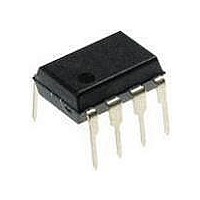PIC12F1840-I/P Microchip Technology, PIC12F1840-I/P Datasheet - Page 56

PIC12F1840-I/P
Manufacturer Part Number
PIC12F1840-I/P
Description
7 KB Flash, 256 Bytes RAM, 32 MHz Int. Osc, 6 I/0, Enhanced Mid Range Core 8 PDI
Manufacturer
Microchip Technology
Datasheet
1.PIC12F1840-IP.pdf
(382 pages)
Specifications of PIC12F1840-I/P
Processor Series
PIC12F
Core
PIC
Program Memory Type
Flash
Program Memory Size
7 KB
Data Ram Size
256 B
Interface Type
MI2C, SPI, EUSART
Number Of Timers
3
Operating Supply Voltage
1.8 V to 5.5 V
Maximum Operating Temperature
+ 85 C
Mounting Style
Through Hole
Package / Case
PDIP-8
Development Tools By Supplier
MPLAB IDE Software
Minimum Operating Temperature
- 40 C
Lead Free Status / Rohs Status
Lead free / RoHS Compliant
Available stocks
Company
Part Number
Manufacturer
Quantity
Price
Company:
Part Number:
PIC12F1840-I/P
Manufacturer:
MICROCHIP
Quantity:
200
- Current page: 56 of 382
- Download datasheet (4Mb)
PIC12(L)F1840
5.3
The system clock source can be switched between
external and internal clock sources via software using
the System Clock Select (SCS) bits of the OSCCON
register. The following clock sources can be selected
using the SCS bits:
• Default system oscillator determined by FOSC
• Timer1 32 kHz crystal oscillator
• Internal Oscillator Block (INTOSC)
5.3.1
The System Clock Select (SCS) bits of the OSCCON
register selects the system clock source that is used for
the CPU and peripherals.
• When the SCS bits of the OSCCON register = 00,
• When the SCS bits of the OSCCON register = 01,
• When the SCS bits of the OSCCON register = 1x,
When switching between clock sources, a delay is
required to allow the new clock to stabilize. These oscil-
lator delays are shown in
5.3.2
The Oscillator Start-up Time-out Status (OSTS) bit of
the OSCSTAT register indicates whether the system
clock is running from the external clock source, as
defined by the FOSC<2:0> bits in the Configuration
Word 1, or from the internal clock source. In particular,
OSTS indicates that the Oscillator Start-up Timer
(OST) has timed out for LP, XT or HS modes. The OST
does not reflect the status of the Timer1 Oscillator.
DS41441B-page 56
bits in Configuration Word 1
the system clock source is determined by value of
the FOSC<2:0> bits in the Configuration Word 1.
the system clock source is the Timer1 oscillator.
the system clock source is chosen by the internal
oscillator frequency selected by the IRCF<3:0>
bits of the OSCCON register. After a Reset, the
SCS bits of the OSCCON register are always
cleared.
Note:
Clock Switching
SYSTEM CLOCK SELECT (SCS)
BITS
Any automatic clock switch, which may
occur
Fail-Safe Clock Monitor, does not update
the SCS bits of the OSCCON register. The
user can monitor the OSTS bit of the
OSCSTAT register to determine the current
system clock source.
OSCILLATOR START-UP TIME-OUT
STATUS (OSTS) BIT
from
Table
Two-Speed
5-1.
Start-up
Preliminary
or
5.3.3
The Timer1 Oscillator is a separate crystal oscillator
associated with the Timer1 peripheral. It is optimized
for timekeeping operations with a 32.768 kHz crystal
connected between the T1OSO and T1OSI device
pins.
The Timer1 oscillator is enabled using the T1OSCEN
control bit in the T1CON register. See
“Timer1 Module with Gate Control”
information about the Timer1 peripheral.
5.3.4
The user must ensure that the Timer1 Oscillator is
ready to be used before it is selected as a system clock
source. The Timer1 Oscillator Ready (T1OSCR) bit of
the OSCSTAT register indicates whether the Timer1
oscillator is ready to be used. After the T1OSCR bit is
set, the SCS bits can be configured to select the Timer1
oscillator.
TIMER1 OSCILLATOR
TIMER1 OSCILLATOR READY
(T1OSCR) BIT
2011 Microchip Technology Inc.
Section 21.0
for more
Related parts for PIC12F1840-I/P
Image
Part Number
Description
Manufacturer
Datasheet
Request
R

Part Number:
Description:
7 KB Flash, 256 Bytes RAM, 32 MHz Int. Osc, 6 I/0, Enhanced Mid Range Core, Nano
Manufacturer:
Microchip Technology
Datasheet:

Part Number:
Description:
MCU, MPU & DSP Development Tools 8 Bit PIC Develop Microcontroller
Manufacturer:
SchmartBoard
Datasheet:

Part Number:
Description:
7 KB Flash, 256 Bytes RAM, 32 MHz Int. Osc, 6 I/0, Enhanced Mid Range Core 8 DFN
Manufacturer:
Microchip Technology

Part Number:
Description:
7 KB Flash, 256 Bytes RAM, 32 MHz Int. Osc, 6 I/0, Enhanced Mid Range Core 8 SOI
Manufacturer:
Microchip Technology

Part Number:
Description:
7 KB Flash, 256 Bytes RAM, 32 MHz Int. Osc, 6 I/0, Enhanced Mid Range Core, Nano
Manufacturer:
Microchip Technology
Datasheet:

Part Number:
Description:
7 KB Flash, 256 Bytes RAM, 32 MHz Int. Osc, 6 I/0, Enhanced Mid Range Core, Nano
Manufacturer:
Microchip Technology
Datasheet:

Part Number:
Description:
7 KB Flash, 256 Bytes RAM, 32 MHz Int. Osc, 6 I/0, Enhanced Mid Range Core, Nano
Manufacturer:
Microchip Technology
Datasheet:

Part Number:
Description:
7 KB Flash, 256 Bytes RAM, 32 MHz Int. Osc, 6 I/0, Enhanced Mid Range Core, Nano
Manufacturer:
Microchip Technology

Part Number:
Description:
7 KB Flash, 256 Bytes RAM, 32 MHz Int. Osc, 6 I/0, Enhanced Mid Range Core, Nano
Manufacturer:
Microchip Technology

Part Number:
Description:
7 KB Flash, 256 Bytes RAM, 32 MHz Int. Osc, 6 I/0, Enhanced Mid Range Core, Nano
Manufacturer:
Microchip Technology
Datasheet:

Part Number:
Description:
7 KB Flash, 256 Bytes RAM, 32 MHz Int. Osc, 6 I/0, Enhanced Mid Range Core, Nano
Manufacturer:
Microchip Technology
Datasheet:

Part Number:
Description:
Manufacturer:
Microchip Technology Inc.
Datasheet:

Part Number:
Description:
Manufacturer:
Microchip Technology Inc.
Datasheet:











